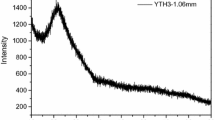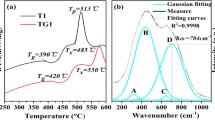Abstract
Holmium (Ho3+) and Ytterbium (Yb3+) co-doped in sol–gel silica glasses are prepared and the effect of incorporating TiO2 and Al2O3 are also studied. Photoluminescence studies using 450 nm excitation show that both TiO2 and Al2O3 improves luminescence but through different mechanisms. The observations are in support of the increased energy transfer between Ho3+ and Yb3+ in the presence of TiO2. Upconversion is also observed with 980 nm excitation showing emission in the green and red regions. Upconversion intensity is also enhanced by TiO2 and Al2O3 but comparison of the intensity ratio of the green and red emissions shows significant back transfer in presence of TiO2.The power dependence study reveals the 5F5 → 5I8 transition of Ho3+ involves a two-step process.

Highlights
-
Both TiO2 and Al2O3 enhance the normal photoluminescence as well as upconversion.
-
Mechanism of luminescence enhancement of Al2O3 and TiO2 are found to be quite different.
-
Incorporation of Al2O3 reduces cross-relaxation between Ho3+ ions.
-
Incorporation of TiO2 increase energy transfer between Ho3+ and Yb3+ ions.
-
Back transfer form Ho3+ to Yb3+ limits the intensity of upconversion.







Similar content being viewed by others
References
Snitzer E (1961) Optical maser action of Nd+3 in a barium crown glass. Phys Rev Lett 7:444–446
Caird JA, DeShazer LG (1975) Analysis of laser emission in Ho3+-doped materials. IEEE J Quantum Electron 11:97–99
Tanabe S (2002) Rare-earth-doped glasses for fiber amplifiers in broadband telecommunication. Comptes Rendus Chim 5:815–824
Righini GC, Enrichi F, Zur L, Ferrari M (2019) Rare-earth doped glasses and light manaing in solar cells. J Phys: Conf Ser 1221:012028
Mascetti J, Fouassier C, Hagenmuller P (1983) Concentration quenching of the Nd3+ emission in alkali rare earth borates. J Solid State Chem 50:204–212
Auzel F (2004) Upconversion and anti-Stokes processes with f and d ions in solids. Chem Rev 104:139–173
Biswas A, Maciel GS, Friend CS, Prasad PN (2003) Upconversion properties of a transparent Er3+-Yb3+ co-doped LaF3-SiO2 glass-ceramics prepared by sol-gel method. J Non-Cryst Solids 316:393–397
Zhang QY, Li T, Jiang ZH, Ji XH, Buddhudu S (2005) 980nm laser-diode-excited intense blue upconversion in Tm3+/Yb3+-codoped gallate-bismuth-lead glasses. Appl Phys Lett 87:171911
Arai Y, Yamashidta T, Suzuki T, Ohishi Y (2009) Upconversion properties of Tb3+-Yb3+ codoped fluorophosphates glasses. J Appl Phys 105:083105
Xu W, Gao X, Zheng L, Zhang Z, Cao W (2012) Short wavelength upconversion emissions in Ho3+/Yb3+ codoped glass ceramic and the optical thermometry behaviour. Opt Express 20:18127–18137
Carnall WT (1963) The near-infrared transitions of the trivalent lanthanides in solution II. Tb3+, Dy3+, Ho3+, Er3+, Tm3+ and Yb3+. J Phys Chern 67:1206–1211
Jørgensen CK, Judd BR (1964) Hypersensitive pseudoquadrupole transitions in lanthanides. Mol Phys 8:281–290
Judd BR (1962) Optical absorption intensities of rare-earth ions. Phys Rev 127:750–761
Ofelt GS (1962) Intensities of crystal spectra of rare-earth ions. J Chem Phys 37:511–520
Carnall WT, Crosswhite H, Crosswhite HM (1978) Energy level structure and transition probabilities in the spectra of the trivalent lanthanides in LaF3, Argonne National Laboratory Report no. ANL-78-XX-95
Peacock RD (1975) In: Dunitz JD, Hemmerich ZP, Holm RH, Ibers JB, Reinen D, Williams RJP (eds.) Rare earths: structure and bonding Vol. 22, Springer-Verlag, Berlin
Yang YM, Yao BQ, Chen BJ, Wang C, Ren GZ, Wang XJ (2007) Judd-Ofelt analysis of spectroscopic properties of Tm3+, Ho3+ doped GdVO4 crystals. Opt Mater 29:1159–1165
Henrie DE, Fellows RL, Choppin GR (1976) Hypersensitivity in the electronic transitions of lanthanide and actinide complexes. Coord Chem Rev 18:199–224
Hehlen MP, Brik MG, Kramer KW (2013) 50th anniversary of the Judd-Ofelt theory: An experimentalist’s view of the formalism and its application. J Lumin 136:221–239
Binnemans K, De Leebeeck H, Gorller-Walrand C, Adam JL (1999) Visualisation of the reliability of Judd-Ofelt intensity parameters by graphical simulation of the absorption spectrum. Chem Phys Lett 303:76–80
Patra A, Reisfeld R, Minti H (1998) Influence of aluminium oxide on intensities of Sm3+ and Pr3+ spectral transitions in sol-gel glasses. Mater Lett 37:325–329
Qiao Y, Da N, Chen D, Zhou Q, Qiu J, Akai T (2007) Spectroscopic properties of neodymium doped high silica glass and aluminium codoping effects on the enhancement of fluorine emission. Appl Phys B 87:717–722
Rai S, Fanai AL (2016) Optical properties of Ho3+ in sol-gel silica glass co-doped with aluminium. J Non-Cryst Solids 449:113–118
Arai K, Namikawa H, Kumata K, Honda T, Ishii Y, Handa T (1986) Aluminum or phosphorus co-doping effects on the fluorescence and structural properties of neodymium-doped silica glass. J Appl Phys 59:3430–3436
Zhou Y, Lam YL, Wang SS, Liu HL, Kam CH, Chan YC (1997) Fluorescence enhancement of Er3+ doped sol-gel glass by aluminium codoping. Appl Phys Lett 71:587–589
Monteil A, Chaussedent S, Alombert-Goget G, Gaumer N, Obriot J, Ribeiro SJL, Messaddeq Y, Chiasera A, Ferrari M (2004) Clustering of rare earth glasses, aluminum effect: experiments and modeling. J Non-Cryst Solids 348:44–50
Dihingia PJ, Rai S (2012) Synthesis of TiO2 nanoparticles and spectroscopic upconversion luminescence of Nd3+ doped TiO2-SiO2 composite glass. J Lumin 132:1243–1251
Lockhead MJ, Bray KL (1995) Rare-earth clustering and aluminium codoping in sol-gel silica: Investigation using Europium (III) fluorescence spectroscopy. Chem Mater 7:572–577
Nogami M, Abe Y (1996) Properties of sol-gel derived Al2O3–SiO2 glasses using Eu3+ ion fluorescence spectra. J Non-Cryst Solids 197:73–78
Miyakawa T, Dexter DL (1970) Phonon sidebands, multiphonon relaxation of excited states, and phonon-assisted energy transfer between ions in solids. Phys Rev B 1:2961–2969
Lowther JE (1976) Mechanisms of energy transfer between rare earth ions. Phys Stat Sol (b) 77:359–366
Acknowledgements
The authors are thankful to Department of Science and Technology New Delhi (India) for financial support (No. SR/S2/LOP-0039/2010). ALF would also like to thank University Grants Commission, New Delhi (India) for financial support through research fellowship (F1-17.1/2015-16/NFST-2015-17-ST-MIZ-3869).
Author information
Authors and Affiliations
Corresponding author
Ethics declarations
Conflict of interest
The authors declare that they have no conflict of interest.
Additional information
Publisher’s note Springer Nature remains neutral with regard to jurisdictional claims in published maps and institutional affiliations.
Rights and permissions
About this article
Cite this article
Fanai, A.L., Rai, S. Effect of TiO2 and Al2O3 on energy transfer and upconversion in Ho–Yb co-doped sol–gel silica glass. J Sol-Gel Sci Technol 97, 452–457 (2021). https://doi.org/10.1007/s10971-020-05424-7
Received:
Accepted:
Published:
Issue Date:
DOI: https://doi.org/10.1007/s10971-020-05424-7




